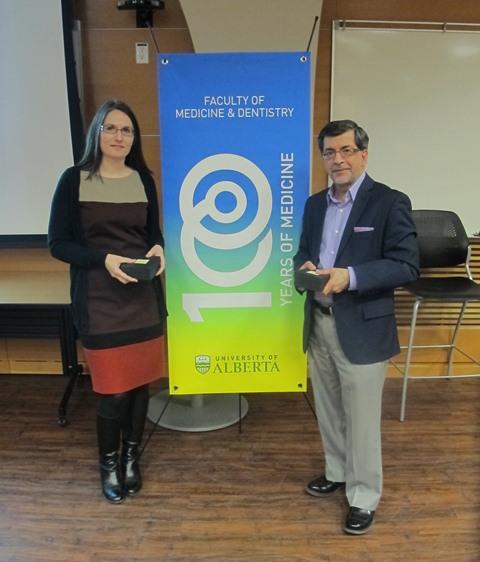
Jacqueline Hebert and Jack Jhamandas
Covering the latest in neuroscience research from "the brain to the fingertips", Jack Jhamandas and Jacqueline Hebert spoke to a group of 120 colleagues and members of the public Monday evening at the Allard Family Lecture Theatre in the Katz Group Centre for Pharmacy & Health Research.
As part of its centennial celebrations, the U of A Faculty of Medicine & Dentistry is hosting a series of lectures to highlight translational research "from bench to bedside" by faculty members who are working to close the gap between the latest scientific discoveries and patient care.
Alzheimer's research
Jhamandas, a neurologist and neuroscientist in the Department of Medicine and the Centre for Neuroscience, gave an overview of his research on Alzheimer's disease, a complex condition which affects one in nine Canadians at age 65. That number increases to one in three at age 85. One of the first known Alzheimer's patients famously said "I have lost myself" to describe the terrible effects of the disease.
Jhamandas and his team have discovered that a drug intended for diabetes appears to restore memory in brain cells affected by Alzheimer's disease. In the lab, the team tested brain tissue from animal models with Alzheimer's disease, looking specifically at the cells' memory capacity. To test memory, they shocked the brain cells with electrical impulses and then measured the cells abilities to "remember" the experience, much like a memory trace.
Researchers have known for a long time of the strong association between Alzheimer's disease and diabetes; if you have diabetes you are at higher risk for Alzheimer's and vice versa. A protein called amyloid which diminishes memory is present in abnormally large amounts in the memory and cognition parts of the brains of Alzheimer's patients. A sister protein, known as amylin, which comes from the pancreas of diabetic patients, has the same impact on memory cells.
Jhamandas and his team decided to try to use AC253, a diabetes drug that never made it to market, to try to block the toxic effects of amyloid protein that lead to brain-cell death. They tested the memory of brain cells from animal models in the lab- some normal and some with Alzheimer's. When AC253 was given to brain cells with Alzheimer's and the shock tests were repeated, the memory trace was restored to levels similar to those in normal cells. When the drug was delivered into the brains of genetically engineered mice destined to develop Alzheimer's disease and cognitive impairment, the treated mice showed significant improvement in tasks requiring memory function compared to their Alzheimer littermates.
"Serendipity plays a big role in science," said Jhamandas. "It was certainly a big part of some of this work.
What's next? "Unfortunately, AC253 does not penetrate the brain very well so the question now is: can we design better drugs, based on the compound AC253, that can penetrate brain cells more easily?"
Advances in prosthetic limbs
Hebert, a member of the Division of Physical Medicine and Rehabilitation, leads the amputee program at the Glenrose Hospital. Her research team studies advanced motor control and sensory feedback systems for upper limb prosthetic devices, a group of projects known as Bionic Limbs for Improved Natural Control (BLINC).
Upper limb amputation advances have lagged considerably behind lower limb technology partly because of the intricacy of the hand and its delicacy, sensation and control. The challenges Hebert and her team are trying to overcome with their research include learning to control the movements of these complex devices, trying to bring sensation of the hand back to the person and trying to design better ways to attach the limb to the person.
Edmonton is still the only centre in Canada providing targeted reinnervation surgeries - procedures that rewire amputated nerve ends into some of the remaining muscle. "You still have the connection from your brain down the nerve that used to power your arm; the arm is gone but the nerves are still there," said Hebert. "The goal is to restore a natural feeling, thought-controlled muscle contraction that then drives the prosthesis to do what it should."
During surgery, Hebert's team splits the muscles and rewires the nerves to link four or five separate muscle sites to the prosthetic control. The patient is then able to think about straightening and bending the arm and opening and closing the hand and the prosthetic movement comes very naturally. The patient can also perform these movements simultaneously rather than one after another. "This in itself is a major advancement in prosthetic control," says Hebert.
These patients not only exhibited improved motor control, they also had restored hand sensation. "So where we had reattached the nerve that controls the hand, when you touched their skin in that area they actually felt like you were touching their hand," said Hebert, explaining that one of the major challenges in prosthetic replacement is the patient's inability to feel where the arm is in space and what the hand is touching. Her team designed a procedure where the sensory nerves were directly reattached to existing skin areas to control the hand map. They then conducted experiments in which the subject could hold and release a ball and could detect when they had done so, as well as identifying the size and density of the ball while blindfolded. "This sensory feedback is so basic to us but is absolutely non-existent in the world of prosthetic use."
Hebert pointed out that the goal for prosthetic limbs is something akin to Luke Skywalker's bionic hand in the "Star Wars" movies - an artificial hand with normal function and sensation. "That's the dream," she said. "But it's no longer an impossible dream."
For more on the Centennial Lecture series and other events celebrating 100 Years of Medicine go to www.med100uofa.ca